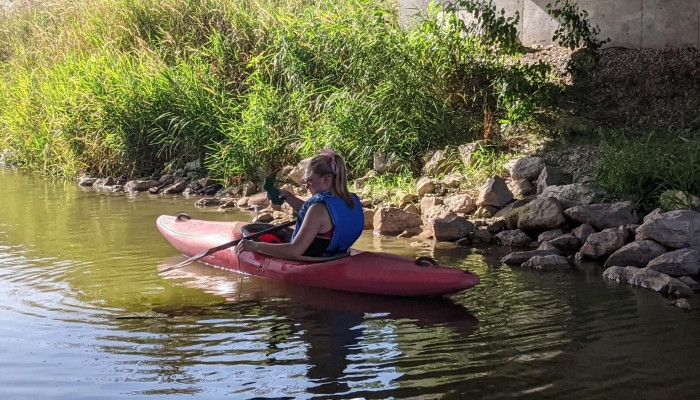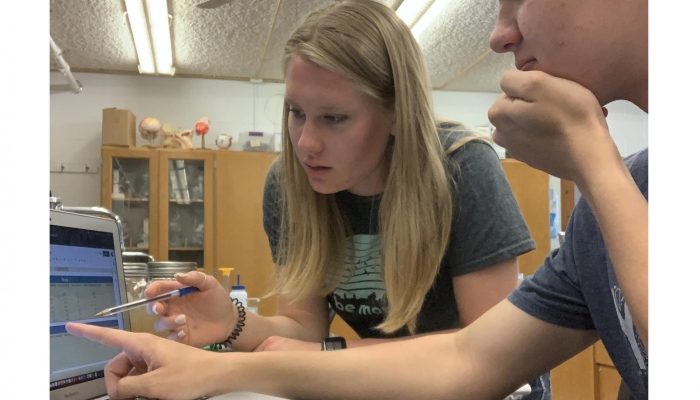Plumbing the Depths for Insights
Student Research Project Looks at Water Quality in NRD Lake
Blayne Winkler might have looked like just another recreationist as he paddled a kayak across Recharge Lake throughout the summer months of 2021; however, it wasn’t a fishing line he cast over the side of his boat. Instead he lowered collection jars to the bottom of the lake on a cord then gently pulled them back up, capped and labeled them, then paddled to the bridge at the northwest side of the lake to trade research partner Emily Eggar full jars for more empty ones. Eggar traveled the perimeter of the lake to gather additional samples from designated locations.
Winkler and Eggar completed a water quality analysis looking for nutrient pollution in the lake at Bruce L. Anderson Recreation Area in York over the summer months. The pair of young researchers collaborated with the Upper Big Blue Natural Resources District staff, who manage the recreation area as well as water quality throughout the district, to design the project.
In September, they presented findings to the board of directors of the NRD. "I was very impressed with not only the initiative Emily and Blayne took but also their findings," said NRD Director John Miller, chairperson of the water and regulations committee. "The presentation they brought to the committee was very professional. My hope is that they or other York College students continue to expand this project."
"We at the NRD are happy to have research conducted by students from our schools in the district," added NRD Director Ronda Rich. "Many times they can see things in a different way than it has been looked at before. There is always room for more ideas. I hope this type of collaboration can continue."
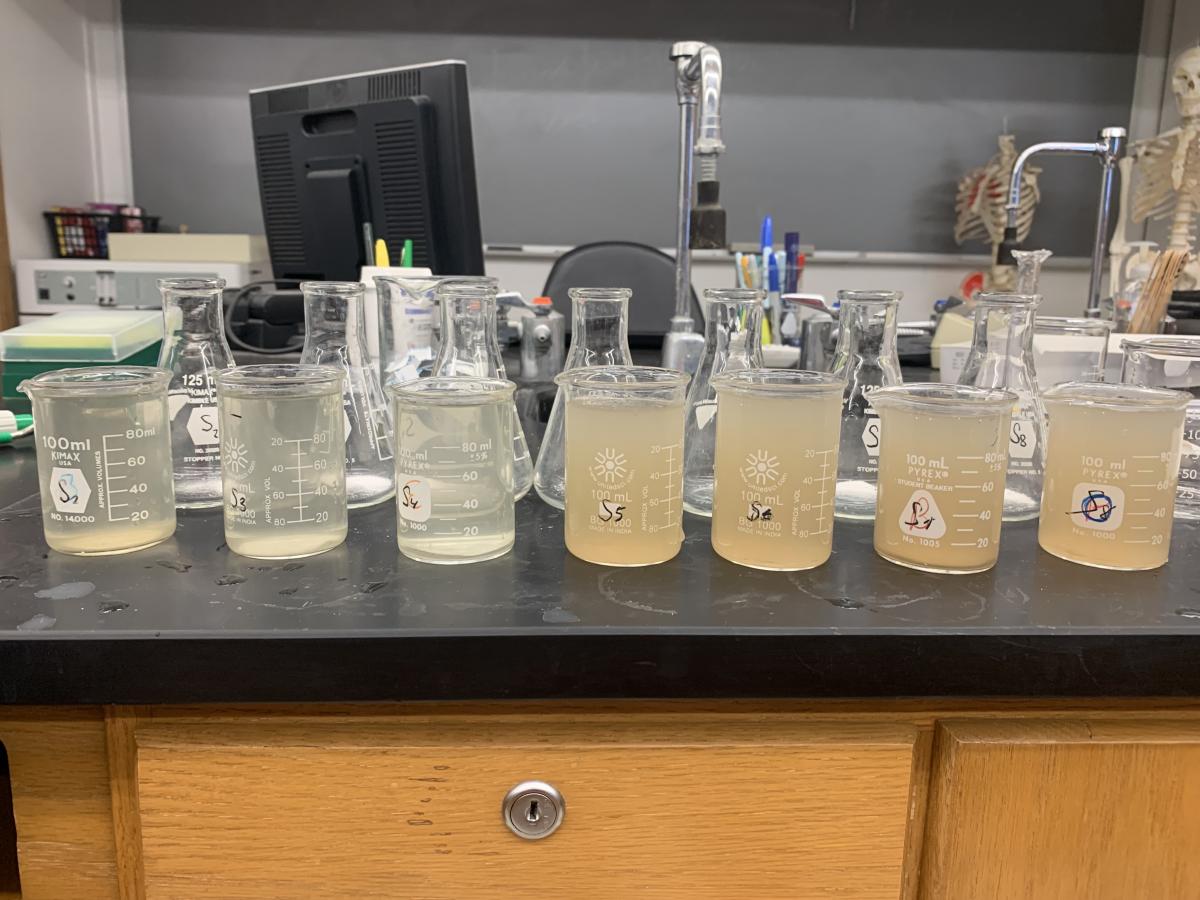
The experiment consisted of collecting deep and shallow water samples from seven locations across the lake, testing the same spots regularly over the span of eight weeks. The project required meticulous data management, as Eggar and Winkler charted not only the readings of chemical concentrations at these locations, but other field observations, like weather conditions and water clarity.
They took their samples to the lab at York College to evaluate with probes and a colorimeter tool purchased for this experiment. The data sets collected averaged three readings for each sample to increase accuracy. Using LabQuest software for data collection and Excel for graph building, the researchers were able to see some trends in the numbers.
Their results indicated that phosphate levels in the lake were high. The EPA recommended amount for lakes and streams is 0.05 mg/L. The levels Winkler and Eggar recorded were 2-4 mg/L. According to the EPA’s website on nutrient pollution, “Too much nitrogen and phosphorus in the water causes algae to grow faster than ecosystems can handle. Significant increases in algae harm water quality, food resources and habitats, and decrease the oxygen that fish and other aquatic life need to survive.” A sustained quantity of phosphorus in a waterbody can lead to harmful algal blooms, which are becoming more common as the climate warms.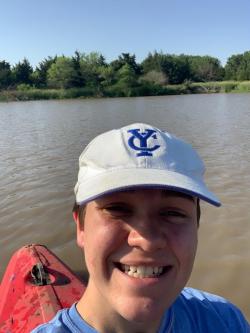
As the NRD has previously reported, the fishery at Recharge Lake is impaired by nutrient pollutants from the agricultural acres that surround the area. The NRD has encouraged producers in the watershed of the lake and Beaver Creek to implement best management practices to reduce the amount of nutrients that make their way into the ground and surface water. A new cost-share program was recently announced to incentivize planting cover crops on these acres, which would minimize nutrient loss from farm fields in the event of heavy rains.
Winkler and Eggar’s research also looked at nitrogen and potassium in the water samples. The nitrogen in their samples from Recharge Lake was not beyond the EPA recommended amount of 10 mg/L. There is not an EPA recommendation for potassium, which they found to be in the 11-14 mg/L range. Their research did not look at bacterial contamination in the water, only chemical. If they had the opportunity to expand the research, they would like to include groundwater samples from the area to see how nutrient pollution impacts ground and surface water differently. They would also like to expand the project to include testing for additional nutrient pollutants and testing throughout the year to see how weather and crop cycles impact water quality. At the moment, they are not planning to continue this study, however they are encouraging other York College students to pursue the research further.
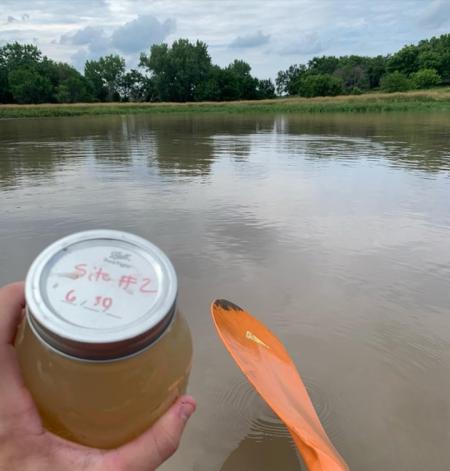
Dr. Stacie Turnbull, formerly a York College instructor of Agribusiness, was the academic advisor on this project. She suggested that Eggar get in touch with the NRD to create the project then encouraged Eggar to apply for a grant through EPSCoR (Established Program to Stimulate Competitive Research), which provides funding for student research at small colleges in Nebraska who don’t have access to the research facilities and budgets that tend to be available at larger universities. Eggar wrote the grant application and Winkler joined her for the collection and analysis parts of the project—for which Eggar was immensely grateful, as she does not like being on boats. The $5,000 they were awarded covered transportation, chemicals, software, and sampling equipment.
The pair says they learned a lot through the process, from applying for funding, to conducting and analyzing the research, to communicating findings to relevant audiences. They also learned more about water quality issues in Nebraska, and the unique way natural resources are managed in the state through the NRD system.
Eggar is a junior from Wolf Point, Montana, double majoring in biology with an emphasis in chemistry as well as pre-professional biology, with a minor in mathematics. She is interested in microbiology and genetics and is planning a career in scientific research and development. When she wasn’t conducting water quality research over the summer, she was rounding out her science knowledge working for Corteva Agriscience in York. Next summer she hopes to work with Meridian Clinical Research at either their Lincoln or Grand Island facility to gain more experience in this area, with the goal of one day working on Alzheimer’s Disease research.
Winkler is looking for competitive internship opportunities in biotechnology for summer ‘22 and ‘23. His primary interest is in pharmaceutical research and vaccine development. He is a junior pre-professional biology major from Lincoln, Nebraska.
Concerned about your water? The NRD offers free analysis for nitrates and bacteria in groundwater for all district residents. Rural domestic wells are not held to public water system regulations; therefore it is the well owners’ responsibility to ensure safe drinking water. These wells should be tested at least once a year for both nitrates and bacteria. If contamination is found, the NRD staff can help you determine next steps to ensure that water is healthy and safe. For more info on our free water testing program, visit the water quality tab of our website and click 'water testing.'
A view of Recharge Lake at Bruce L. Anderson Recreation Area in York.
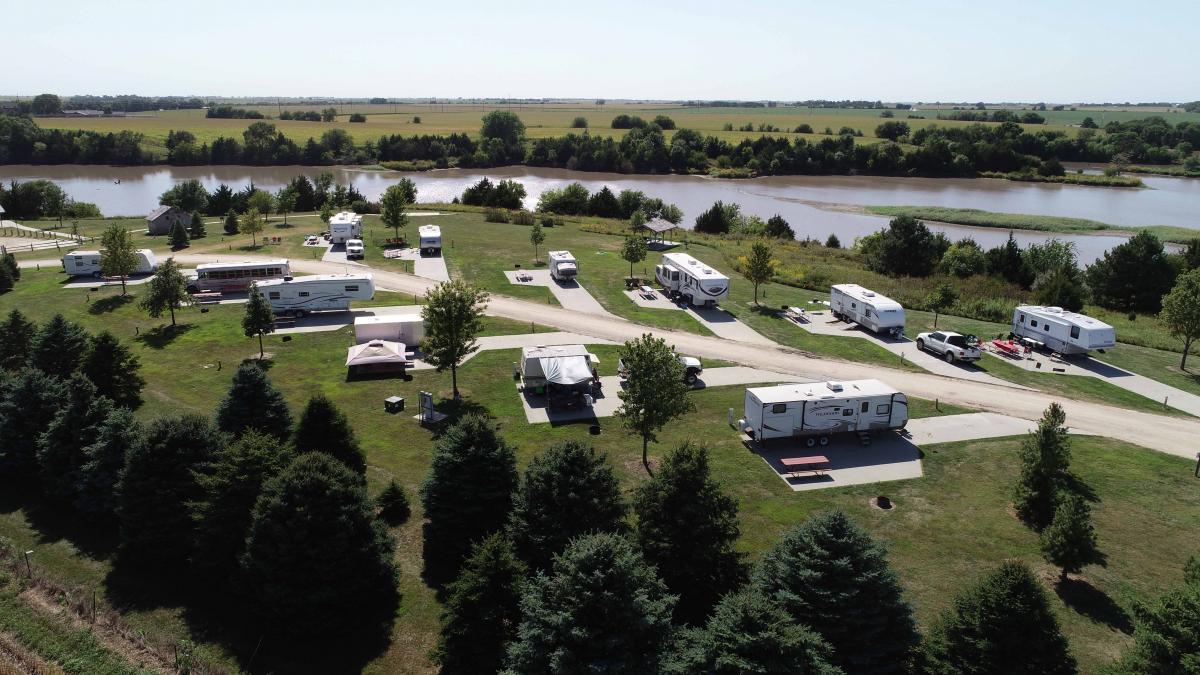
Blayne Winkler might have looked like just another recreationist as he paddled a kayak across Recharge Lake throughout the summer months of 2021; however, it wasn’t a fishing line he cast over the side of his boat. Instead he lowered collection jars to the bottom of the lake on a cord then gently pulled them back up, capped and labeled them, then paddled to the bridge at the northwest side of the lake to trade research partner Emily Eggar full jars for more empty ones. Eggar traveled the perimeter of the lake to gather additional samples from designated locations.
Winkler and Eggar completed a water quality analysis looking for nutrient pollution in the lake at Bruce L. Anderson Recreation Area in York over the summer months. The pair of young researchers collaborated with the Upper Big Blue Natural Resources District staff, who manage the recreation area as well as water quality throughout the district, to design the project.
In September, they presented findings to the board of directors of the NRD. "I was very impressed with not only the initiative Emily and Blayne took but also their findings," said NRD Director John Miller, chairperson of the water and regulations committee. "The presentation they brought to the committee was very professional. My hope is that they or other York College students continue to expand this project."
"We at the NRD are happy to have research conducted by students from our schools in the district," added NRD Director Ronda Rich. "Many times they can see things in a different way than it has been looked at before. There is always room for more ideas. I hope this type of collaboration can continue."

The experiment consisted of collecting deep and shallow water samples from seven locations across the lake, testing the same spots regularly over the span of eight weeks. The project required meticulous data management, as Eggar and Winkler charted not only the readings of chemical concentrations at these locations, but other field observations, like weather conditions and water clarity.
They took their samples to the lab at York College to evaluate with probes and a colorimeter tool purchased for this experiment. The data sets collected averaged three readings for each sample to increase accuracy. Using LabQuest software for data collection and Excel for graph building, the researchers were able to see some trends in the numbers.
Their results indicated that phosphate levels in the lake were high. The EPA recommended amount for lakes and streams is 0.05 mg/L. The levels Winkler and Eggar recorded were 2-4 mg/L. According to the EPA’s website on nutrient pollution, “Too much nitrogen and phosphorus in the water causes algae to grow faster than ecosystems can handle. Significant increases in algae harm water quality, food resources and habitats, and decrease the oxygen that fish and other aquatic life need to survive.” A sustained quantity of phosphorus in a waterbody can lead to harmful algal blooms, which are becoming more common as the climate warms.

As the NRD has previously reported, the fishery at Recharge Lake is impaired by nutrient pollutants from the agricultural acres that surround the area. The NRD has encouraged producers in the watershed of the lake and Beaver Creek to implement best management practices to reduce the amount of nutrients that make their way into the ground and surface water. A new cost-share program was recently announced to incentivize planting cover crops on these acres, which would minimize nutrient loss from farm fields in the event of heavy rains.
Winkler and Eggar’s research also looked at nitrogen and potassium in the water samples. The nitrogen in their samples from Recharge Lake was not beyond the EPA recommended amount of 10 mg/L. There is not an EPA recommendation for potassium, which they found to be in the 11-14 mg/L range. Their research did not look at bacterial contamination in the water, only chemical. If they had the opportunity to expand the research, they would like to include groundwater samples from the area to see how nutrient pollution impacts ground and surface water differently. They would also like to expand the project to include testing for additional nutrient pollutants and testing throughout the year to see how weather and crop cycles impact water quality. At the moment, they are not planning to continue this study, however they are encouraging other York College students to pursue the research further.

Dr. Stacie Turnbull, formerly a York College instructor of Agribusiness, was the academic advisor on this project. She suggested that Eggar get in touch with the NRD to create the project then encouraged Eggar to apply for a grant through EPSCoR (Established Program to Stimulate Competitive Research), which provides funding for student research at small colleges in Nebraska who don’t have access to the research facilities and budgets that tend to be available at larger universities. Eggar wrote the grant application and Winkler joined her for the collection and analysis parts of the project—for which Eggar was immensely grateful, as she does not like being on boats. The $5,000 they were awarded covered transportation, chemicals, software, and sampling equipment.
The pair says they learned a lot through the process, from applying for funding, to conducting and analyzing the research, to communicating findings to relevant audiences. They also learned more about water quality issues in Nebraska, and the unique way natural resources are managed in the state through the NRD system.
Eggar is a junior from Wolf Point, Montana, double majoring in biology with an emphasis in chemistry as well as pre-professional biology, with a minor in mathematics. She is interested in microbiology and genetics and is planning a career in scientific research and development. When she wasn’t conducting water quality research over the summer, she was rounding out her science knowledge working for Corteva Agriscience in York. Next summer she hopes to work with Meridian Clinical Research at either their Lincoln or Grand Island facility to gain more experience in this area, with the goal of one day working on Alzheimer’s Disease research.
Winkler is looking for competitive internship opportunities in biotechnology for summer ‘22 and ‘23. His primary interest is in pharmaceutical research and vaccine development. He is a junior pre-professional biology major from Lincoln, Nebraska.
Concerned about your water? The NRD offers free analysis for nitrates and bacteria in groundwater for all district residents. Rural domestic wells are not held to public water system regulations; therefore it is the well owners’ responsibility to ensure safe drinking water. These wells should be tested at least once a year for both nitrates and bacteria. If contamination is found, the NRD staff can help you determine next steps to ensure that water is healthy and safe. For more info on our free water testing program, visit the water quality tab of our website and click 'water testing.'
A view of Recharge Lake at Bruce L. Anderson Recreation Area in York.


